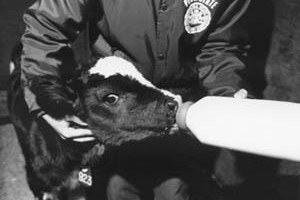
Bottle-feeding a calf
H. H. Havner DVM was the first Chair of Animal Husbandry Extension, holding the position from 1911 to 1929. He was followed by W. B. Connell from 1929 to 1951. Thomas B. King held the chairmanship from 1953 until 1969, when he became head of Department of Animal Science. The extension staff was merged with the Animal Science faculty at that time.
Havner worked with all species, while Connell concentrated on sheep and beef cattle. L. C. Madison (1924-1953) worked with swine, and Charles Burge (1927-1953) assisted with draft horses, beef cattle, and farm slaughtering. King led the extension effort on beef production, and Dwight Younkin carried out many good swine programs. Frank Kreuzberger and Ben Morgan were hired in the mid-1950s; they both worked with sheep and beef. It was during this time that beef cattle production testing was started, as well as feeder calf sales. Lamb pools were established, and wool pools continued after being established by Bill Connell. Lester Burdette joined the staff in 1958 and worked with swine, beef, and 4-H activities. James Gallagher started on staff in 1963 and worked primarily with light horses.
Dwight Younkin initiated a major program shift in the early 1960s when he established a series of swine management clinics and developed a Swine Management Handbook. It was authored by Younkin, Larry Gobble, Grant Sherritt, Samuel Guss (Extension Veterinarian), H. Louis Moore (Extension Marketing Specialist), and L. A. Burdette. All were members of either the Extension or resident staffs in the College of Agriculture.
In the late 1970s, the industry began to change. Swine operations grew larger and became a primary source of income on many farms. The handbook was updated as new management techniques emerged. With the success of the swine program, similar efforts were undertaken with a series of beef cow management clinics and a comparable handbook. Ben Morgan took the leadership role in developing the beef program. He was also primarily responsible for organizing a series of clinics and producing a handbook for the sheep industry.
Animal Science Extension specialists devoted major portions of their time to programs in 4-H and Vocational Agriculture. During the first half of the 20th century, such programs involved the traditional "meat animal" projects and competitions. However, from the 1950s on, interest in pleasure horses and horse shows grew rapidly and prompted the transfer of James Gallagher from a county-based position to the Penn State campus as a horse specialist. Gallagher's working relationship with the horse industry and the backing of the Easter Seals Program of Pennsylvania ultimately led to the establishment of the Therapeutic Horseback Riding Program in the 1970s.
The leadership of Tom King made another unique project available to 4-H club members in the early 1970s. It was The Leader Dog Puppy Raising program and was the start of the process needed to prepare an animal to become a guide dog for the blind. Club members raised the pups from weaning time until they were 14 to 16 months of age. They were then turned over to the Leader Dog for the Blind schools for the remainder of their training.
Extension faculty hired after 1980 were: Clair Engle, sheep; William R. Henning, meats; Kenneth Kephart, swine; John Comerford, beef; Pat Comerford, 4H Horse Program; and Ann Swinker, horse program.
Author: Lester A. Burdette, Professor of Animal Science

